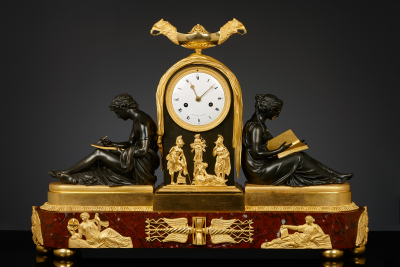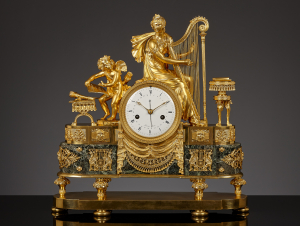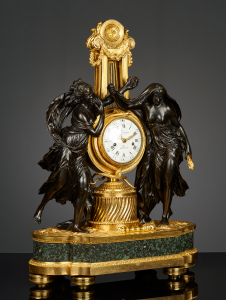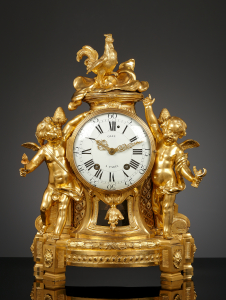French Empire Mantel Clock, l'étude et le philosophie
French Empire Mantel Clock, l'étude et le philosophie
The clock has an eight-day movement with anchor escapement. The mechanism on the countwheel strikes the full hours and once on the half hours. Signed ‘Vaillant á Paris’ on the enamelled dial of the movement. The hours are indicated by Roman numerals and the minutes by Arabic numbers.
The sizable mantel clock and rouge griotte marble base stand on six ball feet. On the centre of the base a patinated clock case, the draped top is headed by an oil lamp flanked by eagle-heads. The case itself is sided by the two patinated figures of Study and Philosophy in the form of a writing man and a reading woman. This model is an interpretation of the common classical model from the 18th century: ‘L'Étude et le Philosophie, after a design by Louis Simon Boizot (1743-1809).
Both ends of the base feature emblematic, gilt bronze mounts in the form of a laurelled eagle. This symbol refers to Napoleon; the eagle heads on the oil lamp at the top are also a direct link to Napoleon's emperorship. The motif of the hourglass on the marble base is a symbol of new life and resurrection. In light of the period following the Revolution, this can be interpreted as a metaphor for the manner in which Napoleon presented himself, namely as a catalyst of progress with an emphasis on the development and stimulation of the sciences.
The central depiction of Diana and Venus on the case may also be seen in this light. It symbolizes the triumph of chastity, or reason, over the promiscuity of the past, or the Ancienne Régime.
Boizot was designer at the Gobelin Manufacture. At the age of sixteen, he began his studies at the Academie Royale de Peinture et de Sculpture. He won the Prix de Rome for sculpture in 1762. From 1773 to 1800, Boizot was director of the sculpture department at the Manufacture Nationale de Sèvres. It was during this time that he was requested to also make designs for clocks. The terracotta models were later produced in patinated or gilded bronze or in white marble. One of his best-known models is the 'l'étude et la philosophy’ that is featured on this clock.
The bronzes are of an exceptionally refined quality, in casting, but also especially in the chiselling. We can therefore suggest that these bronzes possibly originated from the workshops of Pierre Philippe Thomire or Claude Galle.
- Provenance
- Antiques dealer Joseph Damiano, Nice
Private collection, Belgium - Period
- ca. 1805
- Material
- Ormolu and patinated bronze, enamel, griotte red marble base
- Signature
- Vaillant à Paris
- Dimensions
- 53 x 76 x 16 cm
Global shipping available









